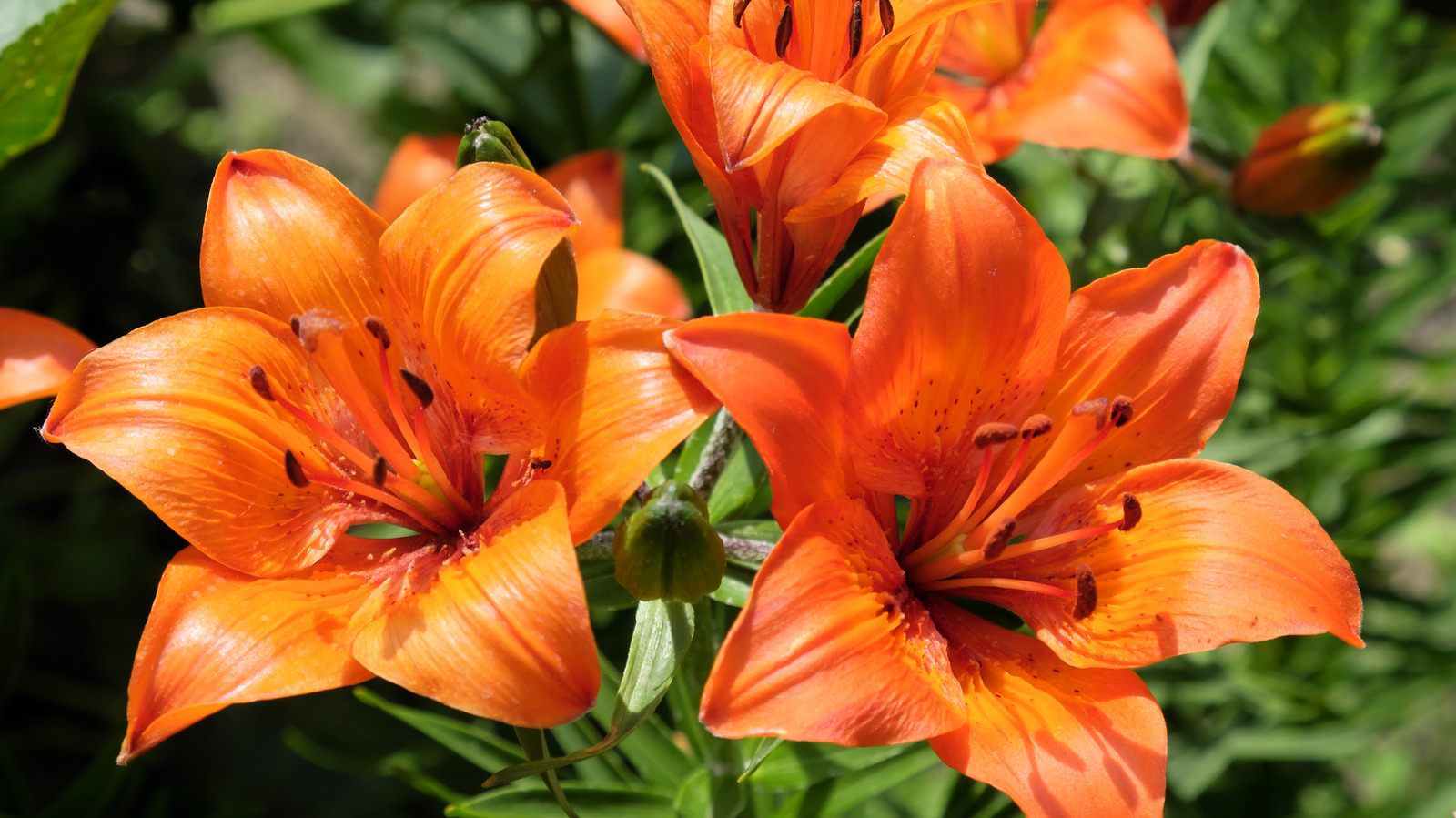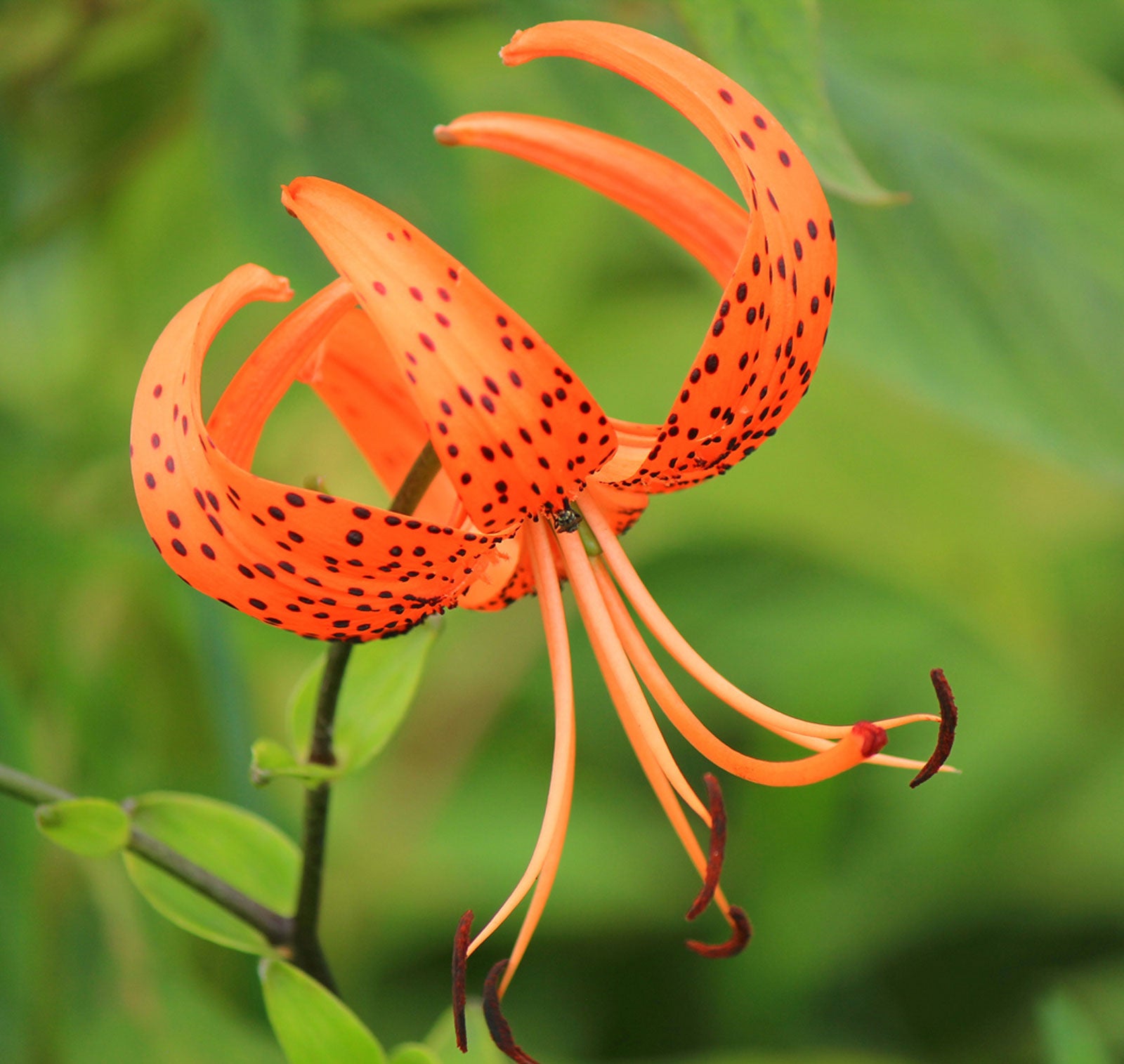Tiger Lily Guide: Grow & Care Tips + Varieties
Are you yearning to inject a burst of vibrant, untamed beauty into your garden? The tiger lily, with its fiery orange petals adorned with dramatic black spots, is a captivating choice, promising to transform any space into a haven of color and intrigue.
The tiger lily, scientifically known as Lilium lancifolium or Lilium tigrinum, is a perennial herbaceous plant, celebrated for its resilience and striking appearance. Native to the eastern regions of Asia, including China, Japan, and Korea, these lilies have captivated gardeners for centuries. They are remarkably adaptable and can thrive in a variety of climates and soil conditions, making them a favorite amongst both novice and experienced gardeners. Their unique, downward-facing blossoms add a touch of exotic elegance to any garden, standing out with their bold, spotted patterns and rich color palettes.
Beyond their aesthetic appeal, tiger lilies hold a certain allure in cultural and symbolic contexts. The vibrant orange hue of many varieties signifies passion, energy, and warmth, while the speckled patterns evoke the wild grace of the animal for which they are named. But, how can one cultivate these enchanting flowers and ensure their enduring presence in their garden? The following sections will provide a comprehensive guide to growing tiger lilies, from planting and care to propagation and variety selection.
- Round1 Fun Bowling Games More Find Your Spot
- Michelle Obama Big Mike Rumors Debunking The Claims Facts
About the Tiger Lily
The tiger lily, Lilium lancifolium or Lilium tigrinum, is a perennial bulbous herbaceous plant. It is renowned for its vibrant orange flowers, speckled with dark spots reminiscent of a tiger's coat. This hardy plant is native to East Asia, thriving in regions of China, Japan, Korea, and the Russian Far East.
Characteristics:
- Explore Lot 10 Kl Shopping Dining Entertainment Guide
- Unveiling Scarlett Rouge Art Family Amp Influences
- Appearance: Features bright orange flowers with black or deep crimson spots, strappy leaves, and long stems.
- Bloom Time: Typically blooms in midsummer.
- Size: Grows to about 1 to 1.5 meters tall and 30 to 60 centimeters wide.
- Hardiness: Very hardy, suitable for a wide range of climates.
- Propagation: Easily propagated through bulbils.
Cultivation Tips:
- Sunlight: Prefers full sun to partial shade.
- Soil: Requires well-draining, loose soil.
- Watering: Needs regular watering, especially during the growing season.
- Fertilizing: Benefits from regular fertilization to support growth and flowering.
- Maintenance: Trimming stems after flowering can help maintain plant health.
Cultural Significance:
- Symbolism: Often associated with passion, energy, and wild beauty.
- Varieties: Available in various colors, including orange, yellow, red, and pink.
Let's now explore the essential steps to successfully cultivating these stunning blooms.
Planting Your Tiger Lilies: A Step-by-Step Guide
The best time to plant tiger lily bulbs is in the spring or fall. This timing allows the bulbs to establish a strong root system before the harsh weather conditions of summer or winter set in. Choose a location that receives ample sunlight. Tiger lilies thrive in full sun, which means at least six hours of direct sunlight per day. If this isn't possible, partial shade can also work, especially in hotter climates.
Soil Preparation: The foundation for any thriving garden is the soil. Tiger lilies demand well-draining soil. Heavy clay soil can be amended by incorporating organic matter, such as compost or well-rotted manure. This will improve drainage and provide essential nutrients. The soil should be loose and rich to facilitate healthy root growth. Dig a hole about 8 inches deep to begin the planting process.
Planting the Bulbs: When planting, space the bulbs about 12 to 18 inches apart to allow for adequate air circulation and growth. Plant the bulbs with the pointed end facing up, and cover them with soil. Water the bulbs thoroughly after planting to settle the soil and initiate growth.
Caring for Tiger Lilies: Essential Practices
Once planted, tiger lilies require consistent care to flourish. Regular watering is crucial, especially during the growing season. Keep the soil consistently moist but not waterlogged. Overwatering can lead to bulb rot, so ensure proper drainage. The frequency of watering will depend on your climate and soil type. In hot, dry climates, more frequent watering may be required.
Fertilizing: To support healthy growth and abundant blooms, fertilize your tiger lilies regularly. A balanced fertilizer, applied in the spring and again after flowering, will provide essential nutrients. Avoid over-fertilizing, which can harm the plant.
Mulching: Applying a layer of mulch around the base of the plants can help retain moisture, suppress weeds, and regulate soil temperature. Organic mulches, such as shredded bark or straw, are excellent choices.
Deadheading: After the flowers have faded, deadheading (removing spent flower heads) can encourage further blooms and prevent the plant from expending energy on seed production.
Seasonal Care: In the fall, after the foliage has died back, you can cut the stems down to the ground. In colder climates, mulching can protect the bulbs during the winter months.
Propagating Tiger Lilies: Expanding Your Collection
One of the most rewarding aspects of growing tiger lilies is their ease of propagation. They produce small, black bulbils in the leaf axils (the point where the leaf joins the stem). These bulbils offer a simple way to expand your garden collection.
Harvesting Bulbils: In late summer or early fall, the bulbils will mature and detach easily from the plant. Collect these and store them in a cool, dry place until spring.
Planting Bulbils: In the spring, plant the bulbils in well-draining soil. It may take a couple of years for the bulbils to mature and produce flowers.
Division: Mature tiger lily clumps can also be divided in the fall. Carefully dig up the bulbs and separate them, replanting them at the appropriate spacing.
Addressing Common Problems:
Although tiger lilies are relatively pest-resistant, some problems may arise. Watch out for aphids, which can be controlled with insecticidal soap or neem oil. Slugs and snails may also be attracted to the foliage; handpicking them or using organic slug baits can effectively manage these pests. Diseases are less common, but ensuring proper air circulation and avoiding overwatering can prevent fungal issues.
Variety is the Spice of the Garden: Exploring Tiger Lily Varieties
While the classic orange tiger lily is a showstopper, several varieties offer unique colors, patterns, and characteristics.
'Flore Pleno': This variety boasts double flowers, adding a unique texture to the garden.
'Citrinum': A yellow variety with subtle spotting, offering a softer color palette.
'Pink Perfection': Features elegant pink blooms with dark spots, adding a touch of romance.
'Enchantment': Known for its vibrant orange-red flowers and upward-facing blooms.
Tiger Lilies in Different Climates and Soils:
Tiger lilies exhibit impressive adaptability, thriving across a broad range of climates. They are generally hardy in USDA zones 3 through 9. While they flourish in various soil types, well-drained, fertile soil is key. Adjusting your care routine to suit your specific climate and soil conditions will maximize their performance.
The Tiger Lily: A Botanical Overview
- Scientific Name:Lilium lancifolium or Lilium tigrinum
- Family: Liliaceae (Lily Family)
- Type: Herbaceous Perennial
- Origin: Native to East Asia (China, Japan, Korea, and Russia)
- Hardiness Zones: USDA Zones 3-9
Physical Characteristics:
- Flowers: Characterized by downward-facing blooms with recurved tepals, predominantly in orange shades with distinctive black spots. Varieties exist in yellow, gold, red, and pink.
- Stems and Leaves: Stems are long, strappy, and green; leaves are lance-shaped.
- Height: Typically grows to 1 to 1.5 meters (3.3 to 4.9 feet) tall.
- Width: Spreads about 30 to 60 centimeters (12 to 24 inches).
Growth and Care:
- Sunlight: Prefers full sun to partial shade.
- Soil: Thrives in well-draining, loose soil.
- Watering: Requires regular watering, especially during the growing season; avoid waterlogging.
- Fertilizing: Benefits from balanced fertilization.
Propagation:
- Bulbils: Produces bulbils in leaf axils, ideal for propagation.
- Division: Mature clumps can be divided in the fall.
Uses and Symbolism:
- Garden Use: Used for ornamental purposes in borders, cottage gardens, and as focal points.
- Symbolism: Represents passion, energy, and is often associated with the wild beauty.
Common Issues:
- Pests: Susceptible to aphids and slugs/snails.
- Diseases: Avoid overwatering to prevent fungal issues.
The tiger lily, beyond its botanical charm, intertwines with cultural narratives and symbolism. Its presence in gardens is not merely aesthetic; its a nod to a rich history and enduring natural beauty. Let's explore its cultural significance.
Symbolism and Cultural Meanings
In many cultures, the tiger lily symbolizes passion, energy, and wild beauty. The vibrant orange color is often associated with warmth and enthusiasm, while the speckled patterns evoke the untamed grace of the tiger. This association makes it a popular choice for gardens and floral arrangements that aim to convey these sentiments.
Tiger Lilies in Art and Literature
The striking appearance of the tiger lily has also made it a subject of inspiration in art and literature. Its distinctive blooms are often depicted in paintings and drawings, and its presence in gardens adds a touch of exotic beauty.
Tiger Lilies in the Garden: Beyond Aesthetics
Growing tiger lilies is more than just a horticultural pursuit; its an opportunity to connect with nature and enjoy the simple pleasures of life.
Benefits of Growing Tiger Lilies:
- Enhances Garden Aesthetics: The vibrant colors and unique patterns add visual interest.
- Attracts Pollinators: Draws bees and butterflies.
- Low Maintenance: Relatively easy to grow and care for.
- Long-lasting Blooms: Provides beauty throughout the summer.
- Easy Propagation: Can be easily propagated via bulbils.
Where to Find Tiger Lilies: Tiger lilies are commonly available at local nurseries and garden centers during the planting seasons. You can also find them online from various reputable nurseries.
Final Thoughts:
The tiger lily, with its radiant blooms and resilience, makes a rewarding addition to any garden. By following these guidelines, gardeners of all levels can cultivate these stunning flowers and enjoy their beauty year after year.



Detail Author:
- Name : Broderick Quitzon DDS
- Username : xolson
- Email : garland62@hotmail.com
- Birthdate : 2002-09-12
- Address : 4482 Hobart Points Port Lomaburgh, WA 40624
- Phone : +1-872-883-0769
- Company : Sporer-Mohr
- Job : Tractor Operator
- Bio : Error asperiores quas magni iste. Suscipit vero quia amet consequatur et natus dolorem voluptate.
Socials
linkedin:
- url : https://linkedin.com/in/erniekerluke
- username : erniekerluke
- bio : Aperiam quaerat ullam et doloremque.
- followers : 6950
- following : 849
twitter:
- url : https://twitter.com/kerlukee
- username : kerlukee
- bio : Nostrum et aut at nihil illo. Earum omnis vel id iure. Voluptas in harum consequuntur quisquam voluptatem minima error.
- followers : 2484
- following : 1421